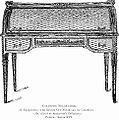Secretary (furniture)

The secretary , or writing cabinet , is a piece of furniture with a writing surface as well as drawers and compartments with and without doors. In contrast to a desk, there are also compartments behind and above the writing surface. In many models, the writing surface can be folded in or covered with a type of roller shutter. This makes the secretary look like a chest of drawers or a cupboard.
The secretary was very popular in the 18th and 19th centuries, especially during the Biedermeier period . It evolved from the cabinet and, unlike the standing desk , was primarily intended for private use. Both can be seen as the forerunners of the desk .
layout
Early copies and Biedermeier

Early examples are borrowed from a cupboard or a chest of drawers, while later ones look more like a table with an attachment. The design of the furniture varied between these functional extremes, but also between the styles of different eras.
The chest of drawers usually had three drawers, but there are also examples from France with lockable doors and rows of drawers hidden behind them. The essay contained sorting compartments, drawers and recesses for ink, paper, documents and the like, and was closed with a desk lid that could be folded out to the front, which when opened served as a writing surface. Over time, there have been a number of changes in the design, for example mirrored doors above the middle section, more legroom for the user, or rows of drawers to the right and left of the central recess of the attachment.
Originally developed as a compact piece of furniture for a wide range of needs, the secretary's design became lighter and more elegant at the end of the 18th century. The solid base gave way to lower parts with more or less imaginatively designed feet and increasingly took on the shape of a table instead of a chest of drawers. The writing surface could be pulled out, and the compartments and drawers above were hidden behind a quarter-circle roller shutter. This part, as well as the type of desk that developed from it, with roller shutters in a semicircle or quarter circle and without an attachment was called the “cylinder bureau”.
The roll-top desk was after 1760 one of the most important furniture of the Parisian cabinetmaker art. Another piece of furniture from France was the little Bonheur du jour . These were women's desks that had hardly any drawers or shelves, but were made even more elaborately, even with mosaic work.
The secretary or writing cabinet reached Germany at the beginning of the 18th century, mainly via England and the Netherlands. This is where the German furniture is mostly also inspired. In contrast to the French and English specimens, these are less often made from exotic precious woods, but more often from local woods, for example with veneers from fruit trees.
A special feature from the Biedermeier era are the so-called blenders , which are cupboards whose front is designed in such a way that it imitates the appearance of a secretary.
Many historical secretaries are equipped with secret compartments that the normal observer could not easily see. This made it possible to hide money, but also confidential letters and documents.
From 1900
With the service society, the reputation of paperwork decreased so that secretaries were no longer made. Since the 1920s, lighter desks, often made of tubular steel, took over their function. Primarily because of the fine woods and elaborate veneer work, historical secretaries are in demand today as antiques and have also been reproduced since around 1970. However, they are mostly used for decoration, since the comparatively small writing surface hardly meets today's demands on a workplace (setting up a computer and telephone, space for a lamp, etc.).
With the advent of laptops that require little space, modern secretaries are again being offered (as of 2020) for setting up home offices, which are more space-saving than desks thanks to the foldable work surface.
gallery
Low bureau from the Louis Seize
Cylinder Secretary of Louis XV.
literature
- Gerhard Dietrich: writing furniture. From the Middle Ages to the Modern , Munich 1986.
- Renate Dolz: Furniture Stylistics . Wilhelm Heyne Verlag, Munich 1997, ISBN 3-453-13046-4 .
- Hermann von Fischer: FONCK A BERNE. Furniture and equipment from the Funk family of craftsmen in the 18th century in Bern , 2nd edition, Bern 2002.
- Gisela Haase: Dresden furniture of the 18th century , 3rd edition, Leipzig 1993.
- Hugh Honor and John Fleming: Lexikon Antiquitäten und Kunsthandwerk , Munich 1980.
- Manuel Kehrli and Monika Bürger: Bernese writing furniture of the 18th century (catalog for the exhibition). Jegenstorf 2008.
Web links
Individual evidence
- ^ A secretary for laptop & Co. In: Der Tagesspiegel. November 28, 2013, accessed March 13, 2020 .
- ↑ Tips & tricks for the perfect home office. July 18, 2019, accessed March 13, 2020 .



